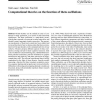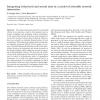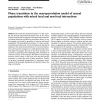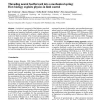BC
2005
13 years 4 months ago
2005
and abstract phase-locked attractor network models of early olfactory systems Received: 12 May 2005 / Accepted: 18 July 2005 / Published online: 8 September 2005
BC
2005
13 years 4 months ago
2005
Motion repulsion is the perceived enlargement of the angle between the directions of motion of two transparently moving patterns. An explanation of this illusion has long been soug...
BC
2005
13 years 4 months ago
2005
Grating cells were discovered in the V1 and V2 areas of the monkey visual cortex by von der Heydt et al. (1992). These cells responded vigorously to grating patterns of appropriate...
BC
2005
13 years 4 months ago
2005
BC
2005
13 years 4 months ago
2005
The spinal neural networks of larval zebrafish (Danio rerio) generate a variety of movements such as escape, struggling, and swimming. Various mechanisms at the neural and network ...
BC
2005
13 years 4 months ago
2005
Abstract We model the dynamical behavior of the neuropil, the densely interconnected neural tissue in the cortex, using neuropercolation approach. Neuropercolation generalizes phas...
BC
2005
13 years 4 months ago
2005
Synchronised activity, differing in phase in different populations of neurons, plays an important role in existing theories on the function of brain oscillations (e.g., temporal co...
BC
2005
13 years 4 months ago
2005
A solution is proposed of the hitherto unsolved problem as to how neural feedforward through inverse modelling and negative feedback realised by a mechanical spring can be combined...




